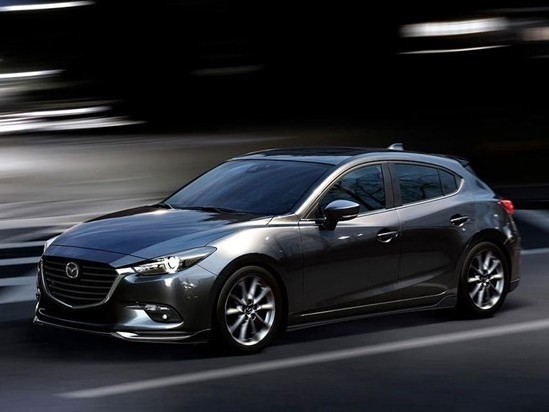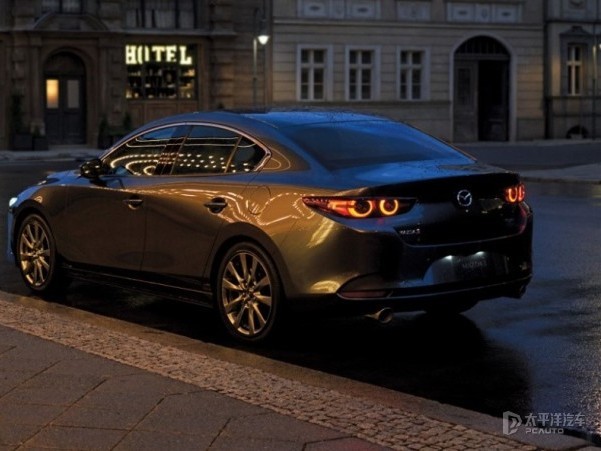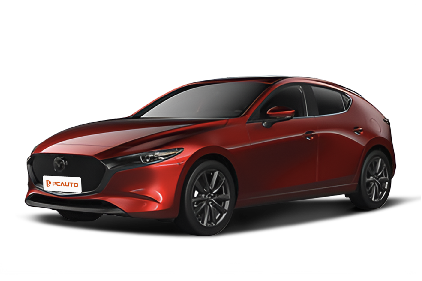Q
What is the Mainentance Cost of Mazda 3 Hatchback? Get Idea Here
The maintenance cost of the Mazda 3 Hatchback in Malaysia is relatively reasonable. According to the officially recommended maintenance intervals and parts prices, the cost of regular maintenance (such as oil and oil filter replacement) is approximately between RM300 and RM500, depending on the type of oil used (mineral oil, semi - synthetic, or full - synthetic) and whether it's done at an authorized service center.
The cost of major maintenance (such as replacing brake fluid, transmission fluid, etc.) can reach between RM800 and RM1,200. However, this type of maintenance is usually only required once every 20,000 to 40,000 kilometers. Mazda's SkyActiv technology has improved fuel efficiency and performance. But it is recommended to use the original - specified parts during maintenance to ensure optimal performance. These parts may be slightly more expensive than third - party parts, but they can extend the vehicle's lifespan and maintain the warranty rights.
For Malaysian car owners, regular maintenance can not only avoid high repair costs but also preserve the vehicle's resale value. This is especially true for popular models like the Mazda 3 Hatchback, which usually perform well in the secondary market. In addition, car owners can further save costs by purchasing maintenance packages or participating in promotional activities. At the same time, it's important to regularly check the tires and braking system, as Malaysia's rainy climate causes significant wear and tear on these two components.
Special Disclaimer: This content is published by users and does not represent the views or position of PCauto.
Related Q&A
Q
What Segment is Mazda 3 Hatchback?
The Mazda 3 Hatchback falls into the C-Segment (also known as compact cars segment) in the Malaysian market, sharing the same class as models like the Honda Civic and Toyota Corolla. This five - door hatchback is popular among young consumers for its dynamic design, refined interior, and excellent handling performance. The Skyactiv - technology engine it's equipped with strikes a balance between fuel efficiency and power output, making it suitable for both city driving and long - distance trips.
In Malaysia, C - Segment models are well - received for their combination of practicality and driving pleasure. The Mazda 3 Hatchback further enhances its competitiveness by offering a wide range of features such as a head - up display and a Bose audio system.
It's worth noting that when Malaysian consumers are making a purchase, they can compare the after - sales warranty policies and spare - parts availability of competing models in the same segment. At the same time, they should also consider their own needs regarding body size and trunk space. Although the hatchback design is stylish, its cargo - carrying capacity is slightly inferior to that of the sedan version. If you often need to carry a large amount of cargo, you may need to weigh the pros and cons.
Q
What is the Reslae Value of Mazda 3 Hatchback?
The Mazda 3 Hatchback has shown stable resale value in the Malaysian used - car market. This is mainly due to its outstanding design, reliable powertrain, and the brand's good reputation. Generally, a three - year - old used Mazda 3 Hatchback can retain 60% to 70% of its original price, depending on the vehicle's age, mileage, and maintenance condition. If the car has been well - maintained and has low mileage, its residual value could be even higher.
Mazda's Skyactiv technology has improved fuel efficiency and the driving experience, further enhancing its market competitiveness. Regular maintenance at authorized service centers and keeping complete records can also significantly increase the used - car value. Moreover, Malaysian consumers prefer Japanese cars for their high durability and low maintenance costs, which makes the Mazda 3 Hatchback quite popular in the used - car market.
For potential buyers, it is recommended to check the vehicle's accident history and repair records. At the same time, compare it with competing models of the same year, such as the Honda Civic or the Toyota Corolla Hatchback, to make a more comprehensive decision.
Q
How Many CC is Mazda 3 Hatchback?
The Mazda 3 Hatchback offers engine options in the Malaysian market, mainly including the 1.5-liter and 2.0-liter Skyactiv-G gasoline engines with displacements of 1496cc and 1998cc respectively. Both of these engines adopt Mazda's advanced Skyactiv technology, which focuses on balancing fuel efficiency and power output. The 1.5-liter version is suitable for daily commuting, while the 2.0-liter version can provide stronger power performance.
For Malaysian consumers, it's important to choose the right engine displacement according to their needs. Displacement not only affects power performance but also road tax and fuel economy. In Malaysia, road tax is calculated based on engine displacement; the larger the displacement, the higher the road tax. Thanks to the optimization of Skyactiv technology, these two engines can achieve good power output while also taking fuel economy into account.
The Mazda 3 Hatchback is very popular among young consumers for its excellent handling and Kodo design language. It's a popular hatchback model in the Malaysian market that combines sportiness and practicality, and it can handle both city driving and occasional long - distance trips.
Q
What is the Engine in Mazda 3 Hatchback?
The Mazda 3 Hatchback mainly offers two high - performance Skyactiv - G gasoline engine options in the Malaysian market, namely the 1.5 - liter and 2.0 - liter four - cylinder naturally aspirated engines. The 1.5 - liter version has a maximum output power of 114 horsepower, which is suitable for daily commuting and has excellent fuel economy. The 2.0 - liter version provides 156 horsepower, with more abundant power. It is also equipped with Mazda's unique Skyactiv - Vehicle Dynamics vehicle dynamic management system, offering more precise handling performance.
Both of these two engines adopt a high - compression ratio design (13:1). Combined with direct - injection technology and a 4 - 2 - 1 exhaust system, they effectively improve combustion efficiency and reduce fuel consumption, while meeting the Euro 5 emission standards in Malaysia. It's worth noting that Mazda's Skyactiv technology optimizes internal engine friction and uses lightweight design. While maintaining the linear power output of the naturally aspirated engine, it also takes environmental protection performance into account, making it suitable for Malaysia's diverse road conditions.
If you have higher performance requirements, you can pay attention to the Skyactiv - X compression - ignition engine version available in overseas markets. Its thermal efficiency is further improved through the SPCCI spark - controlled compression ignition technology. However, this version has not been introduced to Malaysia yet. It is recommended that car owners regularly use the 0W - 20 low - viscosity engine oil recommended by the original factory and 95 - octane or higher gasoline to fully unleash the engine's performance.
Q
What is the Gearbox Type of Mazda 3 Hatchback?
The Mazda 3 Hatchback offers two main types of transmissions in the Malaysian market, namely the 6-speed automatic manual integrated transmission (Skyactiv-Drive) and the 6-speed manual transmission. The specific configuration depends on the model version and the year. Among them, the Skyactiv-Drive automatic transmission is well - known for its smooth shifting experience and fuel economy. It adopts Mazda's exclusive Skyactiv technology, which enhances the driving experience by optimizing transmission efficiency and reducing power loss. The manual transmission version is more suitable for drivers who pursue the joy of control, providing more direct shifting feedback. It's worth mentioning that Mazda's Skyactiv technology not only focuses on performance but also takes environmental protection needs into account, which meets the preference of the Malaysian market for energy - efficient models. If you have further questions about the transmission configuration of specific models, it is recommended to check the official website of Mazda Malaysia or consult local dealers to get the latest information. At the same time, you can also take a test drive to experience the actual performance of different transmissions so as to choose the version that best suits your driving habits.
Q
What is the PCD Size of Mazda 3 Hatchback?
The PCD (Pitch Circle Diameter) of the Mazda 3 Hatchback is 5x114.3. This means there are 5 bolt holes on the wheel hub, and the centers of these holes are distributed on a circle with a diameter of 114.3 millimeters. This specification is quite common in the Malaysian market and is shared by many Japanese - made models such as the Honda Civic and Toyota Corolla, which makes it convenient for car owners to replace or upgrade their wheels. Understanding the PCD size is crucial when replacing wheels or installing new tires, as an incorrect PCD will prevent the wheels from being installed properly, which can affect driving safety.
Apart from the PCD, when choosing wheels, car owners also need to pay attention to the center bore diameter (CB) and the offset value (ET) to ensure a perfect match with the vehicle. In Malaysia, many wheel modification shops are familiar with these parameters. It's recommended that car owners consult professionals or refer to the vehicle manual before modification to ensure compatibility.
The Mazda 3 Hatchback is well - known for its handling and design. A reasonable wheel upgrade can further enhance its appearance and performance. However, it's essential to choose high - quality products that meet the specifications to ensure safety.
Q
Does Mazda 3 Hatchback Have Apple Carplay?
Yes, the Mazda 3 Hatchback in the Malaysian market is indeed equipped with Apple CarPlay. This feature has become standard in recent models, allowing iPhone users to seamlessly connect their phones to the car's display and use apps like navigation, music, and calls. The entertainment system of the Mazda 3 Hatchback also supports Android Auto, meeting the needs of users with different types of phones. Its user interface is clean and smooth, integrating well with the Mazda Connect system, which enhances both convenience and safety while driving. In addition to Apple CarPlay, the vehicle also comes with several practical technologies, such as a Head-Up Display (HUD) and a Bose sound system, further enhancing the driving experience. For Malaysian consumers, the Mazda 3 Hatchback is not only known for its stylish design and handling performance, but its rich technological features also make it a popular choice among cars in the same class. If you value smart connectivity features, this car is worth considering.
Q
What is the Tyre Brand of Mazda 3 Hatchback?
The original - equipped tire brands of the Mazda 3 Hatchback in the Malaysian market may vary depending on the model year and configuration. Common combinations include international brands such as Bridgestone, Dunlop, or Toyo. Specific models, like the Bridgestone Turanza T005A or Dunlop Enasave EC300+, focus on quiet comfort and wet - surface performance, meeting the needs of the local rainy climate. Car owners can confirm the original specifications through the sidewall markings of the tires or the vehicle manual. It is recommended to choose tires that match the original size (e.g., 215/45 R18) and load index to ensure safety.
If replacement is needed, similar products such as the Michelin Primacy 4 or Goodyear EfficientGrip can be considered. They also emphasize low rolling resistance and durability. However, it should be noted that the dry and wet - surface performance and wear - resistance index of tires from different brands may affect the driving experience.
In Malaysia, where it is hot and rainy, regularly checking the tire pressure and tread depth (it is recommended to be no less than 1.6 millimeters) can extend the tire life and improve fuel economy. Pay more attention to the drainage performance before the rainy season to prevent skidding.
Q
Is Mazda 3 Hatchback a Good Car? Learn the Pros and Cons Here
The Mazda 3 Hatchback is a compact hatchback that's quite popular in the Malaysian market. Its advantages include a stylish and dynamic exterior design, delicate interior craftsmanship, and excellent handling performance. The Skyactiv - technology engine it's equipped with strikes a good balance between fuel economy and power output. Meanwhile, the standard i - Activsense safety system offers leading active and passive safety features in its class.
However, the rear - seat space is relatively cramped, and the maintenance and repair costs are slightly higher than some Japanese competitors. The sporty suspension tuning might not meet the comfort needs of some consumers. For Malaysian consumers, this car is especially suitable for young people who pursue driving pleasure. Its Kodo design language also enjoys high popularity in the local car modification circle.
It's worth noting that in tropical climates, it's advisable to choose ventilated seats and regularly check the air - conditioning system. At the same time, the 5 - year warranty policy provided by the manufacturer can effectively reduce the cost of car ownership. Among models in the same class, you can also refer to the Toyota Corolla Hatchback or the Honda Civic Hatchback for a horizontal comparison. It's recommended to take a test drive and then make a choice according to your personal needs.
Q
What is the Width of Mazda 3 Hatchback?
According to official data, the body width of the Mazda 3 Hatchback is 1,795 millimeters. This dimension puts it in the upper - middle range among compact hatchbacks in the Malaysian market. It offers both a comfortable seating space and great maneuverability for city driving. For Malaysian consumers, this width ensures that they don't feel cramped when driving on narrow streets or in parking lots, while also guaranteeing sufficient lateral space for passengers inside the car.
The Mazda 3 Hatchback features the brand's unique Kodo design language. The smooth body lines not only enhance the car's visual dynamism but also optimize its aerodynamic performance. In Malaysia's tropical climate, the car's air - conditioning system can effectively cool the entire cabin, ensuring a comfortable driving and riding experience.
Notably, the handling performance of the Mazda 3 Hatchback has also received wide acclaim. Its precise steering and stable cornering performance are well - suited to Malaysia's winding roads. Additionally, this car is equipped with a wealth of safety features, such as blind - spot monitoring and lane - keeping assist systems, which provide extra protective support for Malaysian drivers.
Latest Q&A
Q
What kind of oil does 2018 Passat use?
For the 2018 Volkswagen Passat in Malaysia, the recommended oil specs typically call for synthetic oils that meet VW 502 00 or VW 504 00 standards, with viscosity grades of 5W-30 or 5W-40 being the go-to choices. Your final pick should really depend on your actual driving conditions and habits though – here in Malaysia's hot climate, for example, 5W-40 might be the better bet thanks to its stronger high-temperature protection.
Sticking to regular oil changes is huge for keeping your engine running strong long-term. As a general rule, aim to change it every 10,000 kilometers or 12 months, whichever comes first. Also, when you're picking out oil, always double-check that it has international certifications like API SN or ACEA A3/B4 – that's your guarantee of reliable quality.
If your Passat has a diesel engine or is a high-performance variant, it might need a specific oil type, so your best move is to check the owner's manual or have a chat with an authorized service center. It's also handy to know what those oil numbers mean – "5W" tells you about cold-weather flow, while "40" refers to hot-temperature thickness. A little knowledge here goes a long way in helping you make the smartest choice for your car.
Q
Does a 2018 Volkswagen Passat have a turbo?
The 2018 Volkswagen Passat in Malaysia does come with a turbocharged engine, specifically a 1.8-liter TSI turbocharged petrol unit. This engine pushes out 180 horsepower and 250 Nm of torque, and it's a solid combo of turbo tech and direct injection that delivers great power while still being kind on fuel – perfect for both city commuting and those longer highway drives we Malaysians love. Turbocharging works by compressing the intake air, which boosts engine efficiency and power, so you get plenty of torque even at low revs, making acceleration feel smooth and effortless.
On top of that, the 2018 Passat also gets VW's DSG dual-clutch gearbox, which really sharpens up the shifts and makes the whole driving experience that much more engaging. For Malaysian buyers, a turbo engine isn't just about daily driving needs; it also gives you that extra oomph for confident overtaking on the highway. And let's not forget, Volkswagen's reputation for reliability and their widespread after-sales network here mean owning one is pretty hassle-free.
If turbo tech has caught your interest, it's worth checking out turbo models from other brands like Toyota or Honda too – each has their own engineering twists. But when it comes to balancing power and fuel efficiency, VW's TSI engines really stand out from the pack.
Q
Are there any recalls on a 2018 VW Passat?
For the record, the 2018 Volkswagen Passat was subject to safety-related recalls in certain markets. In North America, for instance, a recall was issued due to a potential fault in the fuel pump control unit that could lead to stalling. As for the Malaysian market, it's best to refer to official Volkswagen announcements there. We recommend owners check via the recall inquiry page on Volkswagen Malaysia's website by entering their Vehicle Identification Number (VIN) or contact an authorized service center directly, as recall situations can vary by region based on local regulations and vehicle specifications.
Staying on top of recall information is a key part of vehicle maintenance, especially for updates involving critical components like airbags, fuel systems, or electronic stability programs. Even if your Passat isn't part of a recall, sticking to the manufacturer's maintenance schedule is crucial to keep it running at its best. For more details on common upkeep points specific to the Passat—think DSG transmission care or turbocharged engine maintenance tips—reaching out to local Volkswagen technicians is the way to go for personalized advice.
Q
What is the fuel consumption of the 2018 Volkswagen Passat?
The 2018 Volkswagen Passat's fuel economy in the Malaysian market varies depending on the powertrain. The 1.8-liter TSI turbocharged engine variant delivers a combined fuel consumption of around 6.5 liters per 100 kilometers, while the 2.0-liter TSI model is slightly thirstier at approximately 7.2 liters per 100 kilometers. Real-world figures, of course, can fluctuate based on driving habits, road conditions, and maintenance upkeep.
Riding on Volkswagen Group's proven MQB platform and paired with a DSG dual-clutch transmission, this model strikes a nice balance between power delivery and fuel efficiency – ideal for both city commutes and highway stretches across Malaysia. It's worth highlighting how turbocharging technology effectively boosts performance from smaller-displacement engines while keeping fuel consumption relatively low, a trend we've seen increasingly adopted in mid-size sedans here in the local market.
To keep your Passat running at its most efficient, regular maintenance is key. Make sure to replace the air filter and spark plugs as scheduled, and always use engine oil that meets the manufacturer's specifications. These simple steps go a long way in preserving optimal fuel economy over time.
If you're in the market for a used Passat, do yourself a favor and check the complete service history through official channels. It's the best way to ensure the vehicle still performs as well as it did when it left the factory.
Q
Why is my 2018 Passat not starting?
There are a few common reasons why your 2018 Passat might be refusing to start. First up, battery issues. Malaysia's hot and humid climate can really take a toll on battery life, so it's worth checking if the voltage has dropped below 12.4 volts or if the terminals are looking corroded.
Next, a faulty starter motor or alternator could be the culprit – both can leave you short on electrical power. Don't rule out fuel system problems either, like a busted fuel pump or a clogged fuel filter. These tend to happen more often if you've been using low-quality petrol regularly.
Then there's the ignition system; worn spark plugs or a dodgy ignition coil can definitely make starting a hassle. If your Passat has a smart key, don't forget to check if the key fob battery is dead, which might stop the car from recognizing it.
If any warning lights are flashing on the dashboard – especially the check engine light – hook up an OBD scanner to read the trouble codes as soon as you can. For regular maintenance, swap out the battery every 2-3 years, stick to the recommended fuel grade, and replace the spark plugs around every 60,000 kilometers. These simple steps can go a long way in preventing starting headaches. If you've checked all this and still can't get it going, best to reach out to an authorized service center for a professional diagnosis.
View MoreRelated News

Seeing the Ferrari Purosangue reminds one of the Mazda 3 Hatchback
Kevin WongDec 2, 2024

2023 Mazda 3 Hatchback: Six colors, two configurations, is it worth RM160,000?
JohnOct 17, 2024

Mazda 3 Hatchback, priced from RM166,059, how to choose between the two models?
AshleyJul 15, 2024

Rumor: Toyota and Mazda collaborate to develop the next-generation MX-5 and GR86
AshleySep 30, 2025

MAZDA EZ-60 will be launched in China, and will be available in other global markets in 2026
RobertSep 30, 2025
View More


















Pros
Cons